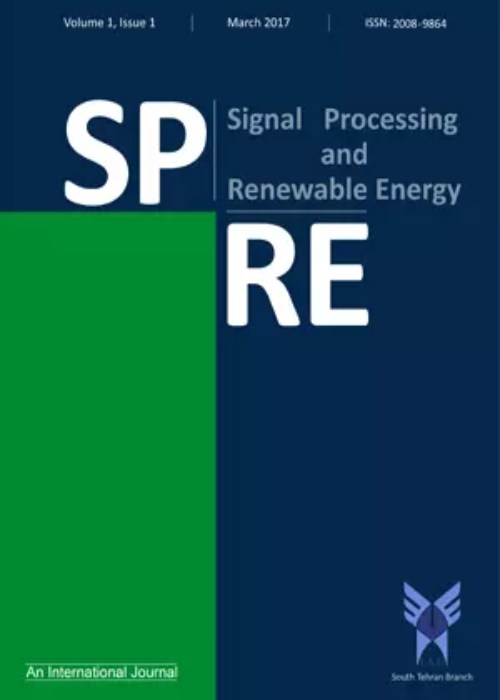فهرست مطالب
Signal Processing and Renewable Energy
Volume:2 Issue: 2, Spring 2018
- تاریخ انتشار: 1397/03/11
- تعداد عناوین: 6
-
Pages 1-13
Emotion recognition plays a critical role in the human communications. It is one of the major ways to be in touch with others. Four parameters including eye opening size, mouth opening size, ratio of eye opening size to eye width and mouth width are used as a reduced-size feature set in this study. This paper compares the performance of facial emotion recognition classification models based on the following computational intelligence methods fuzzy logic, chaotic gravitational search algorithm (CGSA), and artificial neural network (ANN) from eyes and mouth features tested on the FACES database. Experimental results show the superior performance of ANN-based method compared to fuzzy- and CGSA-based methods. In addition, this comparative study triggers the idea of a hybrid system based on these computational methods that outperforms the human detection system.
Keywords: fuzzy logic, Artificial Neural Network, chaotic GSA, emotion recognition -
Pages 15-24
Quantum-dot cellular automata (QCA) is a novel technology that encodes binary information with state of electrons instead of voltage levels. QCA computations offer ultra-low power consumption, high speed and density construction. Majority voter and inverter are the most important gates in this technology and other gates and circuits can be implemented with them. In this paper, we design a novel fault tolerant two-input XOR gate. That is implemented in single layer without any wire crossing. One of the fundamental logical gates in digital circuits is exclusive-OR (XOR). Many circuits can be implemented with XOR such as full adder, comparator and so on. We design this gate according to Boolean expressions with one three-input majority gate and one five-input majority gate. The proposed design has significant improvement in terms of area, complexity, latency, and cell count in comparison to the previous designs. This component is suitable for designing fault tolerant QCA circuits. We simulate our design in QCA Designer and QCA Pro and achieved results are presented in this paper.
Keywords: Quantum-dot cellular automata(QCA), Exclusive-OR (XOR), Fault tolerance, Majority gate, QCA Designer -
Pages 25-29
Increase of energy consumption and air pollution are big crises in recent two decades. Due to these crises and also increase of energy costs, utilization of hybrid electric vehicles becomes conventional and vehicle companies are increasing their investment in these kinds of vehicles. The main issue for these vehicles, besides energy storage system, is efficiency of electric motor and its weight and cost. Axial Flux Permanent Magnet Synchronous Motors (AFPMSM) have become popular for hybrid vehicles as they have better efficiency and less weight. In this paper an AFPMSM, which would be used in hybrid electric vehicles, is designed to get less weight and cost and more efficiency. PSO and GA algorithms have been applied in this design. Inner and outer diameter of axial flux permanent magnet motor and air gap flux density are taken as variables in the mentioned design.
Keywords: hybrid vehicle, PSO, GA, AFPMSM, Optimization -
Pages 31-35A new method for decreasing the number of Quantum Dot Cells in Quantum Dot Cellular Automata (QCA) circuits is presented. The proposed method is based on physical modeling between electrons. Correctness of presented method is proved using some physical proofs. Our method is useful for QCA circuits with many inverter gates. It should be noted that in order to achieve more stability, the potential energy of QCA electrons reach the minimum level. The proposed approach can be used for designing any QCA arithmetic circuit.Keywords: Quantum- dot cellular automata (QCA), Nanoelectronic circuits, Inverter
-
Pages 37-44
Data gathering is a common but a critical operation in many applications of wireless sensor networks. So, innovative techniques that improve energy efficiency to prolong the network lifetime are highly required. In this research, we analyze the reduction of energy consumption in wireless sensor networks. A sensor network consists of a large number of limited-energy sensor nodes, which are widely distributed in an environment that sense and collect the environmental information. In most applications of wireless sensor networks, there is no possibility of charging node batteries. In these types of networks, the most important challenge is the power constraint that directly affects the lifetime of the sensor network. Protocols designed in these networks should be accompanied by efficient energy consumption. The LEACH protocol is one of the well-known protocols that are widely used in this field. In this study, we use genetic algorithm and fuzzy clustering for improving the LEACH protocol. Our results show that the proposed algorithm has needs energy consumption in comparison with the original version. This leads to a prolonged network lifetime, which is one of the most important issues in wireless sensor networks.
Keywords: Wireless Sensor Network, Network lifetime, Genetic Algorithm, LEACH protocol, C-means clustering -
Pages 45-49In this article, a compact ultra-wideband monopole antenna with notch band characteristic is presented. The proposed antenna has a notch-band for rejection of WiMAX frequency at 3.5GHz. Here, we show the ability of controlling the notch frequency with some changes in U-slot. The antenna has the bandwidth of 3.1-16 GHz with the notch at 3.2-3.8GHz with high rejection and VSWR of notch around 16. The prototype antenna based on monopole antenna with dual U-shape slots is fabricated. The antenna ground contains a T slot for matching. The antenna has Omni-directional pattern in E-plane and bi-directional pattern in H-plane. The antenna gain has altered from -8 to 5.9 dB at the range of 2–16 GHz, with an average gain of 4.2 dBi. The total size of the antenna is 12×18×1.6 mm3. The multi U line controls the current distribution, while it can be replaced by pin diode for achieving reconfigurable structure.Keywords: UWB, U-slot, notch, Monopole antenna


